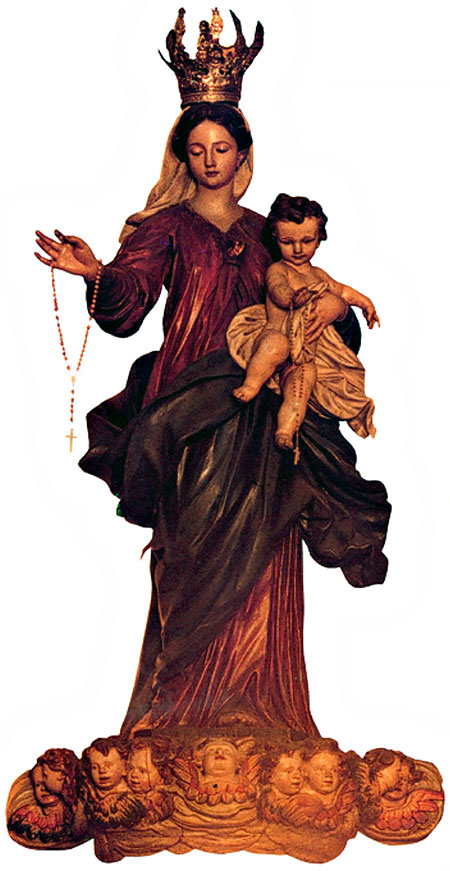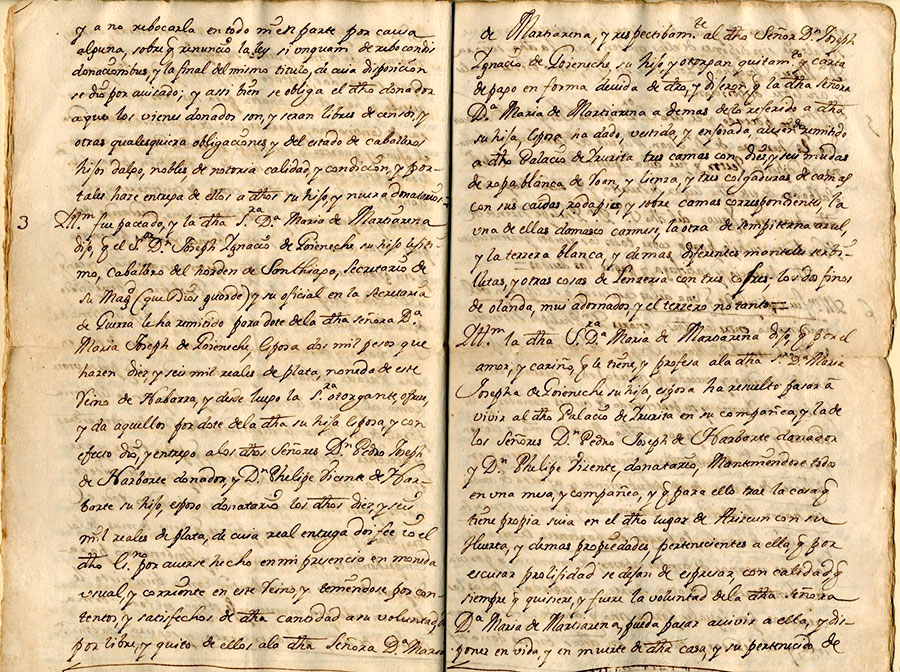The piece of the month of March 2023
ABOUT THE REGISTRATION OF THE VIRGIN OF THE ROSARY OF IRURITA, A WORK OF JUAN DOMINGO OLIVIERI, 1749.
Ricardo Fernández Gracia
Chair of Navarrese Heritage and Art
University of Navarra
Among the works that left news of their origin, motivation, names and dates, the Virgin of the Rosary of Irurita, work of Juan Domingo Olivieri (1749), paid for by the Goyeneche brothers, stands out for its value. The paternity of the sculpture was made known by Professor García Gainza in 1986, who offered a first reading of the registration.

Our Lady of the Rosary of the parish of Irurita,
by Juan Domingo Olivieri, 1749.
The text provides three aspects of information: the first concerns the funders, the second, the motivation, and the third, the artists. We will dwell on these subjects in an attempt to penetrate beyond the text itself. For its reading, we propose this order: "JPH YGº, THOMAS Y PEDRO FRANCº DE GOYENECHE, A DEBOZ. DE MARIA MARTIA(RENA). IN MADRID YEAR 1749. ECHª Pr OLIVIERI ESCR. PINTO PEÑA".
As for the donors, there are not two -Tomás and Pedro Francisco- but three, since the brother of both, José Ignacio de Goyeneche y Martiarena, also participated. All of them natives of Elizondo, they were sons of Juan de Goyeneche y Erráuriz, owner of the Martiarena de Arizcun manor, and María de Martiarena, who married in 1704. All three reached high positions in the Bourbon administration. The first of them, José Ignacio (1705-1776), was knight of Santiago and commander of Villafranca, officer in the administrative office of the Office of War, secretary of the king, secretary of Crusade and secretary of New Spain in the committee of the Indies. Years later, in 1770, he played an important role in choosing design to build the main altarpiece of Irurita, through Don Vicente Pignatelli. In 1764 he was appointed to the administrative office of Grace and Justice of the House of Castile, position which he held until his death on September 29, 1776. He left his brother Pedro Francisco Goyeneche Martiarena as his heir.
Tomás, who died in 1748, was the first treasurer of the factory of the New Royal Palace from 1737 until his death, just one year before the date of Irurita's sculpture.
Pedro Francisco was commissioner of War, assigned to Italy in the service of the Marquis de la Ensenada. He replaced his brother Tomás at the head of the Bursar's Office of the new palace or royal palace of Madrid, position which he occupied until he was assigned to other duties, such as the sale of the Jesuits' goods in Old Castile or the army quartermaster in Aragón, Navarra and Guipúzcoa. He ended up as war advisor.
The second part of the registration gives a precise account of the reason for the commission, the devotion to the Virgin of the Rosary of María de Martiarena, mother of the three. At this point we can ask ourselves the reasons for this, since Maria was a native of Arizcun and married in Elizondo. The reason is that the mentioned Maria de Martiarena came to live in the palace of Irurita when her daughter Josefa de Goyeneche married Don Felipe Vicente de Narvarte, owner of that lot, in 1736. The marriage contracts of both were very clear in this respect when in one of its clauses it was stipulated that María de Martiarena
for the love and affection that he has and professes to the said Mrs. Josefa de Goyeneche his daughter, wife, has resolved to move to live in the said palace of Irurita in her company and that of Mr. Pedro José de Narbarte, donor, and Mr. Felipe Vicente, donee, keeping all at a table and company, and for this he brings the house that he owns in the said place of Arizcun with his orchard and other properties belonging to it and to excuse prolixity are left unexpressed, with quality that whenever she wants and it was will of the said Mrs. María de Martiarena, she can pass to live to her and to dispose in life of this house and her property belonged of goods in favor of whom well seen it seemed to her, with that if she lacks without disposing of them they remain for the said Mrs. María Josefa de Goyeneche, her daughter, as endowments and to her free disposition.
María Josefa died without children on January 5, 1754, after having dictated testament on the 2nd of the same month, ordering to be buried in a grave of the parish of Irurita, proper of the Jauregia palace, where her father was buried. She named her husband as heir and mentions in the document her brothers José Ignacio and Pedro Francisco, to whom we have referred before, and also Justo Pastor, captain of cavalry and knight of Santiago, and Juan Antonio, commissioner of War. To her cousin Ana Engracia de Goyeneche, who lived with her, she left 20 ducats, and to her father, who lived in Elizondo, another amount. She also left several alms to different people and different prizes for the image of the Virgin of the Rosary: her best jewels, her silk wedding dress, as well as a silver crown. This last piece was to be made, as agreed with her husband, because of her "special devotion" to the image. Regarding her mother she affirms:
because of the great respect and love I have for the said Mrs. María de Martiarena, my mother, to whom the trust I have with my husband corresponds, I charge you and ask you to take care of my mother's attendance and decency with the law that you have practiced until now, so much to the liking of your mercy and to my satisfaction, with whose consolation I order and command that when she dies [...] she be buried and honored and buried in one of those of the palace, as she has statement with her husband and universal heir.
The aforementioned Maria, mother of the Goyeneche family, died a few months later that same year, on September 17, 1754.

Marriage contracts of Don Felipe Vicente de Narvarte, owner of that plot, with Josefa Goyeneche in 1736, in one of whose clauses it appears that the mother of the latter, María de Martiarena, and of her brothers mentioned in the registration of the sculpture would live in the palace of Irurita.
file de Jaureguía Irurita.
The third part of the text gives an account of the authors of the piece, the sculptor Juan Domingo Olivieri and the painter Juan Bautista de la Peña. The signatures of the sculptors, as is well known, became more frequent in the 18th century, but what is very rare is that there is also a record of the polychromator, Juan Bautista de la Peña. Gian Domenico Olivieri (1708-1762) was a sculptor trained in Carrara and Genoa who arrived in Madrid in 1739 to direct the sculptural project of the Royal Palace, thanks to the fame acquired by his works in Turin. Among his functions was that of the training of Spanish artists, for which he founded a private academy that would become the future Royal Academy of Fine Arts, to be hosted by the monarch. He was the first director with a sculpture practice. His work focused on the palace in ornaments, portraits, medals and busts. The image of Irurita is very rare for being worked in wood, compared to the bulk of its production that was work in stone.
The painter Juan Bautista de la Peña (c. 1710-1773) trained with Miguel Ángel Houasse and obtained a pension to perfect his art in Italy in 1730. After returning to Madrid, he was appointed Pintor de Cámara in 1739 and actively participated in the board Preparatory of the Academy, of which he was lieutenant director of painting. He had a bad temper and was vain, violent and jealous, which caused clashes with other masters such as Mengs and with the Academy itself, from which he was expelled when he was not appointed director of Sculpture in 1753. Perez Sanchez judges his work as average, cold, licked and of little originality.
On the sculpture itself, Professor García Gainza made a detailed analysis, highlighting its A quality and dependence on mannerist models.
SOURCES AND BIBLIOGRAPHY
file of the Jauregia Palace of Irurita. Marquisates of Casa Torre and Santa Rosa de Lima, no. 18 (12). Marriage certificates of Felipe Vicente de Narvarte and María Josefa Goyeneche. 1736.
file General of Navarra. Notarial Protocols. Elizondo, Juan José Elizalde. 1754.
PÉREZ SÁNCHEZ, A. E., Catalog de Dibujos. II. Spanish Drawings. Siglo XVIII (C-Z), Madrid, Museo del Prado, 1977.
GARCÍA GAINZA, M.ª C., "Virgen del Rosario, signed by Olivieri", file Español de Arte, n.º 235 (1986), pp. 324-329.
CRUZ YABAR, M.ª T., "José de Hermosilla y el retablo de Irurita en Navarra", file Español de Arte, n.º 290 (2000), pp. 51-65.
